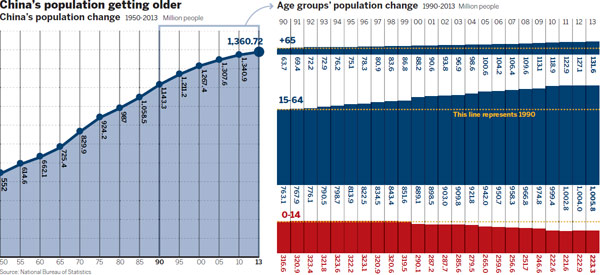

Chinese society is aging much faster than expected and with the working-age population declining, children have become a pressing issue for the country.
The British economist Thomas Robert Malthus could not have expected his book An Essay on the Principle of Population published in 1798 would become a Bible for the family planning authority in China more than 200 years later.
Malthus argued a fast increase in population causes famine, a specter that has haunted China since warlords controlled swathes of the country in the early 1900s.
In an open letter to young people in the late 1970s, China's then Ministry of Health earnestly tried to persuade each couple to have only one child, and have it late, to save food and resources. The logic was quite convincing for people living a hand-to-mouth life in a planned economy.
The benign persuasion finally evolved into the compulsory family planning policy that was implemented for more than 30 years, allowing most couples to have just one child. It has been claimed the measure succeeded in reducing China's potential population by 300 million over roughly three decades, and saved food and resources accordingly, for not just China but the whole world.
In fact, from 1980 to 2010, China's annual consumption of resources and energy increased fourfold, while its population increased by 30 percent, official data show.
Today, the family planning strategy has gone far beyond the realm of public administration, as it has reshaped at least three generations' concept of the family. "One couple, one child" has become the standard of modernity and normality, and the more children a couple have the more abnormal and backward the family seems to be.
Yet, the fertility rate, the average number of children a woman bears, in China today is far below the basic replacement fertility rate of 2.1. The family planning commission said its most recent survey in 2006 shows the rate was 1.87. The World Bank said China's fertility rate after 2010 has remained at 1.7.
Many experts suggest the actual rate is lower than 1.4, arguing it is in the interests of the government to exaggerate the figure to counter voices calling for an end to family planning, as it is a lucrative source of revenue that can bring in hundreds of billions of yuan each year in the form of the social compensation fees, which are de facto fines, paid by couples who contravene the family planning policy.
In 2013, under mounting pressure from the public and the media, two-thirds of the provincial regions disclosed the scale of the fees that had been collected, allocated and used in an opaque way for years, releasing the figures for the fees they had collected the preceding year. The 19 regions collected 16.6 billion yuan ($2.77 billion) in 2012.
Overdue reform
China merged the former National Family Planning Commission, a ministry-level department, with the former Ministry of Health to form a new National Health and Family Planning Commission in 2013.
Last year, the family planning policy was reformed to address the fast aging of the population, allowing couples, in which either party is a single child, to have a second child.
But only 920,000 couples applied to have a second child in the first year of its implementation, a small number compared with the 16 million births each year in China. In Shanghai, less than 5 percent of qualified couples applied. The Shanghai government said that the city's fertility rate is just 0.7, the lowest among major cities in the world.
Chinese society is aging much faster than expected. China's census in 2010 put the overall population at 1.34 billion. In the past 10 years, researchers have altered their prediction of the population peak, with forecasts ranging from 1.4 billion in 2030 to 1.6 billion in 2050.
The latest UN prediction is that China will see its peak population of 1.39 billion in 2026, when the number of senior citizens above 60 years old will hit 411 million, up from 171 million in 2010, and the working-age population will fall to 696 million from 817 million in 2010.
Privilege of the rich
The relaxing of the family planning policy may have come too late, and the government must improve its public services to encourage eligible couples to have another child.
"China will almost certainly have low fertility rate in 20 years, even if the government abolishes all birth controls," said Cai Yong, a sociologist at the University of North Carolina.
Copyright ©1999-2018
Chinanews.com. All rights reserved.
Reproduction in whole or in part without permission is prohibited.